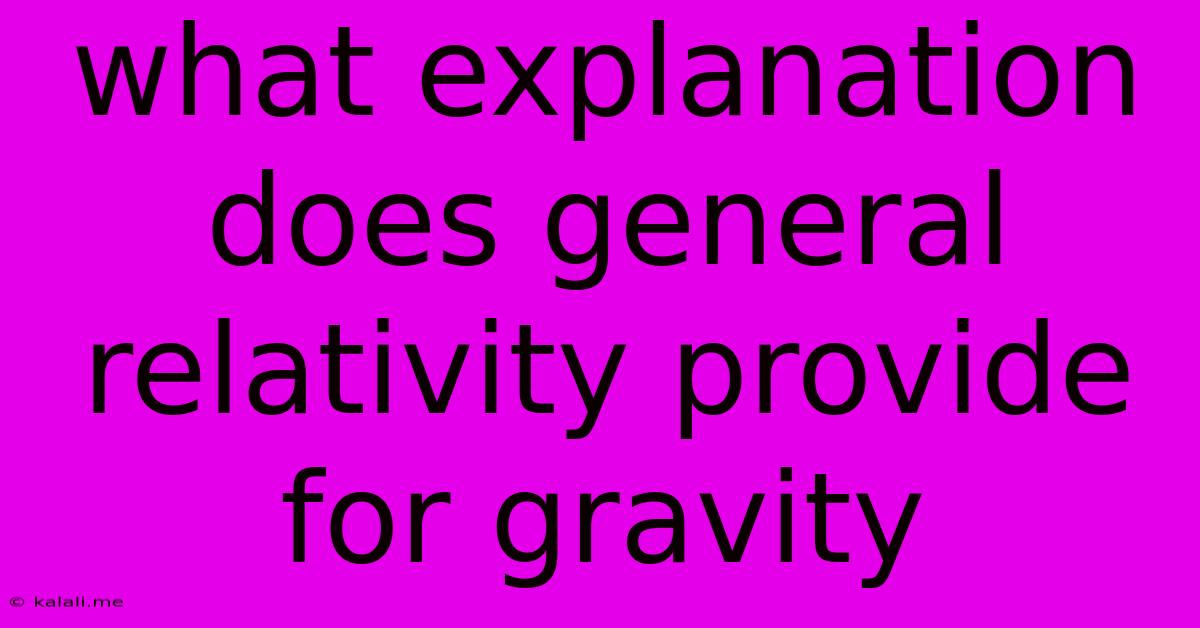What Explanation Does General Relativity Provide For Gravity
Kalali
May 25, 2025 · 3 min read

Table of Contents
What Explanation Does General Relativity Provide for Gravity?
Meta Description: General relativity revolutionized our understanding of gravity, replacing Newton's law with a geometric interpretation. This article explores Einstein's groundbreaking theory, explaining how it describes gravity as the curvature of spacetime caused by mass and energy.
Gravity, a force that governs the motion of celestial bodies and keeps our feet firmly planted on the ground, has fascinated scientists for centuries. Newton's law of universal gravitation provided a remarkably accurate description of gravity's effects, but it left some fundamental questions unanswered. Einstein's theory of general relativity, proposed in 1915, offered a radically different and more complete explanation, revolutionizing our understanding of gravity and the universe itself.
Instead of describing gravity as a force, general relativity portrays it as a geometric property of spacetime. Spacetime is a four-dimensional continuum combining the three spatial dimensions (length, width, height) with time. According to general relativity, massive objects warp or curve the fabric of spacetime around them. This curvature is what we experience as gravity.
The Curvature of Spacetime: A Key Concept
Imagine a bowling ball placed on a stretched rubber sheet. The ball creates a dip or curvature in the sheet. If you roll a marble nearby, it will curve towards the bowling ball, not because of a force pulling it, but because it's following the curvature of the sheet. This analogy, while simplified, captures the essence of general relativity's explanation of gravity.
Massive objects, like planets and stars, behave similarly. Their presence curves spacetime, and other objects moving through this curved spacetime follow these curves, appearing to be "attracted" to the massive object. The more massive the object, the greater the curvature of spacetime, and thus the stronger the gravitational effect.
Geodesics: The Paths of Objects in Curved Spacetime
In general relativity, objects move along paths called geodesics. In flat spacetime (where there's no gravity), geodesics are straight lines. However, in curved spacetime, geodesics are the shortest paths between two points, which are curved paths due to the curvature of spacetime itself. Planets orbiting a star, for instance, aren't pulled into the star by a force; instead, they are following the curved geodesic path dictated by the star's warping of spacetime.
Key Differences from Newton's Law
General relativity differs significantly from Newton's law in several crucial aspects:
- Nature of Gravity: Newton described gravity as a force acting at a distance, while Einstein describes it as a manifestation of spacetime curvature.
- Speed of Gravity: Newton's law implies instantaneous gravitational interaction, while general relativity predicts that gravitational effects propagate at the speed of light.
- Gravitational Field Strength: Newtonian gravity predicts a constant gravitational field strength irrespective of the object's speed, whereas general relativity accounts for variations in gravitational field strength based on the object's velocity and the strength of the gravitational field.
- Black Holes and Gravitational Waves: General relativity predicts phenomena like black holes (regions of spacetime with such strong gravity that nothing, not even light, can escape) and gravitational waves (ripples in spacetime caused by accelerating massive objects), which are not predicted by Newton's law.
Experimental Verification
General relativity has been extensively tested and verified through various experiments and observations. The precession of Mercury's orbit, gravitational lensing (the bending of light around massive objects), and the detection of gravitational waves are all strong confirmations of Einstein's theory.
General relativity provides a profoundly elegant and powerful explanation for gravity. It not only explains the observed gravitational phenomena more accurately than Newton's law but also opens up new avenues for understanding the universe, including cosmology and the search for a quantum theory of gravity. The curvature of spacetime remains a cornerstone of modern physics and a testament to Einstein's genius.
Latest Posts
Latest Posts
-
Changing From Synthetic Oil To Regular Oil
May 25, 2025
-
What Better Way To Celebrate Than
May 25, 2025
-
How To Know If Your Mac Is Charging
May 25, 2025
-
What Happens When A Frog Pees On You
May 25, 2025
-
How Much Is A Bag Of Holding 5e
May 25, 2025
Related Post
Thank you for visiting our website which covers about What Explanation Does General Relativity Provide For Gravity . We hope the information provided has been useful to you. Feel free to contact us if you have any questions or need further assistance. See you next time and don't miss to bookmark.